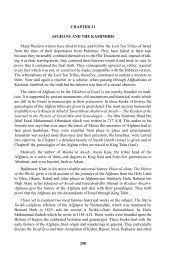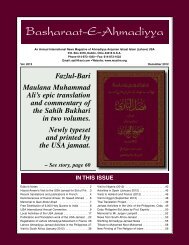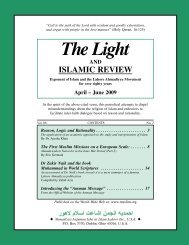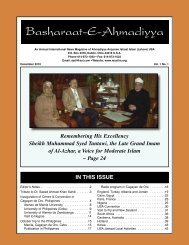From Arabia to the Himalayas - The Lahore Ahmadiyya Movement in ...
From Arabia to the Himalayas - The Lahore Ahmadiyya Movement in ...
From Arabia to the Himalayas - The Lahore Ahmadiyya Movement in ...
Create successful ePaper yourself
Turn your PDF publications into a flip-book with our unique Google optimized e-Paper software.
LAHORE AHMADIYYA MOVEMENT AND ALBANIA IN INTER-WAR PERIOD 10<br />
muezz<strong>in</strong>s). When Salih Vuçitern called for reform <strong>in</strong> 1927, reactions were not slow <strong>in</strong><br />
com<strong>in</strong>g. <strong>The</strong> same th<strong>in</strong>g happened when <strong>the</strong> regional medrese’s were suppressed or when <strong>the</strong><br />
abolition of wear<strong>in</strong>g <strong>the</strong> veil was decreed <strong>in</strong> 1937. <strong>The</strong> most virulent reactions came from<br />
Shkodra, <strong>the</strong> metropolis of nor<strong>the</strong>rn Albania, bastion of Muslim traditionalism. 50 Even so, it is<br />
likely that <strong>the</strong> reformist tendency that monopolised <strong>the</strong> mach<strong>in</strong>ery of <strong>the</strong> Islamic Community<br />
was out of step not only with <strong>the</strong> religious folk of Shkodra, but also with those of o<strong>the</strong>r parts<br />
of <strong>the</strong> country. This opposition can be gauged by an announcement made by <strong>the</strong> edi<strong>to</strong>rs of<br />
Zani i naltë <strong>in</strong> 1933. Accord<strong>in</strong>g <strong>to</strong> <strong>the</strong>m, <strong>the</strong> journal was not <strong>the</strong> mouthpiece of <strong>the</strong> ulema, but<br />
of <strong>the</strong> Islamic Community, that is, <strong>the</strong> organisation represent<strong>in</strong>g <strong>the</strong> Muslim sec<strong>to</strong>r of <strong>the</strong><br />
population. <strong>The</strong>y added that <strong>the</strong>re were no clergy <strong>in</strong> Islam and that <strong>the</strong> aim of <strong>the</strong> journal was<br />
not <strong>to</strong> defend <strong>the</strong> hojas and form a parasitic clique liv<strong>in</strong>g off <strong>the</strong> general public, but <strong>to</strong><br />
contribute <strong>to</strong> <strong>the</strong> nation’s cultural, social and economic development accord<strong>in</strong>g <strong>to</strong> <strong>the</strong> precepts<br />
of <strong>the</strong> Koran. 51<br />
Beyond this struggle for legitimacy between reformists and traditionalist ulema, <strong>the</strong>re<br />
could be <strong>the</strong> problem of <strong>the</strong> <strong>Ahmadiyya</strong> <strong>Movement</strong>’s image <strong>in</strong> <strong>the</strong> Muslim world. Outside <strong>the</strong><br />
country, we have seen that it had been possible for <strong>the</strong> Albanian Muslims’ connections with<br />
<strong>the</strong> Anjuman <strong>to</strong> turn problematic. At Cairo, <strong>in</strong> 1935, three students had been unable <strong>to</strong><br />
cont<strong>in</strong>ue <strong>the</strong>ir journey <strong>to</strong> <strong>Lahore</strong>. Four years later, two o<strong>the</strong>rs were expelled from al-Azhar<br />
and had <strong>to</strong> renounce <strong>the</strong>ir Ahmadi beliefs. It should be noted that <strong>the</strong>se <strong>in</strong>cidents did not s<strong>to</strong>p<br />
<strong>the</strong> Albanian Islamic Community publish<strong>in</strong>g ano<strong>the</strong>r letter from <strong>the</strong> Anjuman <strong>in</strong> its periodical<br />
publication <strong>in</strong> 1940. Yet this same publication, <strong>in</strong> 1936, had echoed a reaction from <strong>the</strong><br />
Albanian Muslim community itself. A reader was denounc<strong>in</strong>g <strong>the</strong> deviant views of <strong>Lahore</strong>’s<br />
young Albanian students, who, <strong>in</strong> <strong>the</strong>ir journal Drita, had written that Joseph was <strong>the</strong> fa<strong>the</strong>r of<br />
Jesus. And he concluded: “this defama<strong>to</strong>ry doctr<strong>in</strong>e com<strong>in</strong>g from <strong>the</strong> Islamic movement <strong>in</strong><br />
<strong>Lahore</strong> has been contradicted by all <strong>the</strong> competent scholars <strong>in</strong> <strong>the</strong> Muslim world. We want<br />
our students <strong>to</strong> br<strong>in</strong>g us culture and not a defama<strong>to</strong>ry doctr<strong>in</strong>e that is aga<strong>in</strong>st <strong>the</strong> Koran”. 52<br />
Already <strong>in</strong> 1933, a doubt did exist <strong>in</strong> some m<strong>in</strong>ds s<strong>in</strong>ce two young Muslims from Shkodra<br />
appear <strong>to</strong> have taken <strong>the</strong> trouble <strong>to</strong> write <strong>to</strong> <strong>the</strong> Sheikh of al-Azhar <strong>to</strong> ask him what view <strong>to</strong><br />
take of <strong>the</strong> <strong>Ahmadiyya</strong> movement. 53 Should one also see <strong>in</strong> this critical approach a reflection<br />
of <strong>the</strong> fact that <strong>the</strong> Albanian Islamic Community did not have <strong>the</strong> translation of <strong>the</strong> Koran by<br />
Muhammad Ali translated <strong>in</strong><strong>to</strong> Albanian? Did those ulema capable of carry<strong>in</strong>g out such a<br />
translation refuse <strong>to</strong> make use of this controversial text? <strong>The</strong> question rema<strong>in</strong>s open. 54<br />
<strong>The</strong> def<strong>in</strong>itive obstacle seen by <strong>the</strong> Albanian reformists <strong>to</strong> <strong>the</strong> propagation of Lahori<br />
Ahmadi Islam was <strong>the</strong> imposition of <strong>the</strong> communist regime at <strong>the</strong> end of <strong>the</strong> Second World<br />
War. In 1945, <strong>the</strong> new authorities <strong>in</strong>tercepted <strong>the</strong> last parcel of books sent by <strong>the</strong> Anjuman <strong>to</strong><br />
<strong>the</strong> young Ismail Muçej and advised, that is <strong>to</strong> say, enjo<strong>in</strong>ed <strong>the</strong> latter — charged by <strong>the</strong><br />
Indians with open<strong>in</strong>g an agency <strong>in</strong> Albania — <strong>to</strong> break off his correspondence with <strong>Lahore</strong>.<br />
50 On reactions <strong>to</strong> <strong>the</strong> reform project launched by Salih Vuçitern <strong>in</strong> 1927, cf. Zani i naltë (year 1927), and on<br />
reactions <strong>to</strong> <strong>the</strong> abolition of wear<strong>in</strong>g <strong>the</strong> veil <strong>in</strong> 1937, see Morozzo della Rocca 1990, pp. 35–36.<br />
51 ‘Detyra jonë’, Zani i naltë, nos. 2–3, tetuer–nanduer 1933, pp. 16–19. In <strong>the</strong> article <strong>in</strong> <strong>The</strong> Light cited <strong>in</strong> notes 22<br />
and 41, Sherif Putra came out very strongly aga<strong>in</strong>st <strong>the</strong> Mullas and ‘mullaism’.<br />
52 ‘Si u kriju Krishti?’, Zani i naltë, nos. 10–11, tetuer–nanduer 1936, p. 351.<br />
53 Cf. Luli-Dizdari-Bushati 1997, pp. 585–586.<br />
54 Let us recall that, on <strong>the</strong> o<strong>the</strong>r hand, <strong>the</strong> translation by Muhammad Ali was translated <strong>in</strong><strong>to</strong> Turkish <strong>in</strong> 1934 (cf.<br />
supra, note 15), and that this Turkish translation formed <strong>the</strong> basis of a translation <strong>in</strong><strong>to</strong> Serbo-Croat published <strong>in</strong><br />
Sarajevo <strong>in</strong> 1937 by M. Pandža and Dž. Čaušević (Popovic 1973). Accord<strong>in</strong>g <strong>to</strong> Fethi Mehdiu (1996, p. 99), one<br />
Shejh Jahja, son of Shejh Shefqet of Djakovica (Kosovo), had made a translation of <strong>the</strong> Koran <strong>in</strong><strong>to</strong> Albanian on <strong>the</strong><br />
basis of <strong>the</strong> translation of Pandža and Čaušević and that of Karabeg. But this translation rema<strong>in</strong>ed <strong>in</strong> manuscript.<br />
In Albania, Hafiz Ibrahim Dalliu, who applied himself <strong>to</strong> a translation-commentary of <strong>the</strong> Koran <strong>in</strong> <strong>the</strong> 1930’s,<br />
used o<strong>the</strong>r works. He po<strong>in</strong>ts out, however, that he has taken “Indian Muslim scholars” as a model when he gives<br />
<strong>the</strong> verses <strong>in</strong> transcription for those who are unfamiliar with <strong>the</strong> Arabic script (Bardhi 1998, p. 128).



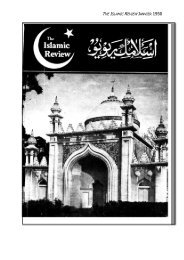
![Part 2] HARD TRIALS NECESSARY TO ESTABLISH TRUTH 69 152 ...](https://img.yumpu.com/11777151/1/167x260/part-2-hard-trials-necessary-to-establish-truth-69-152-.jpg?quality=85)

